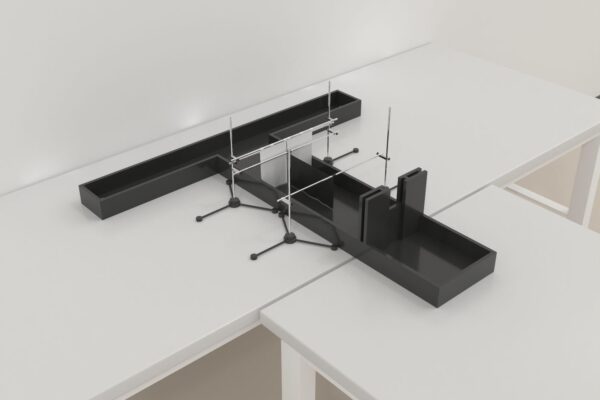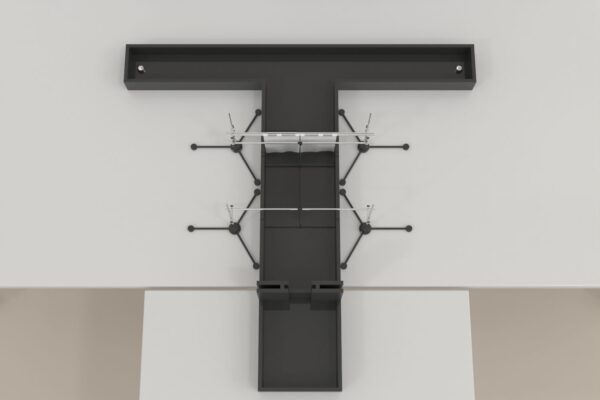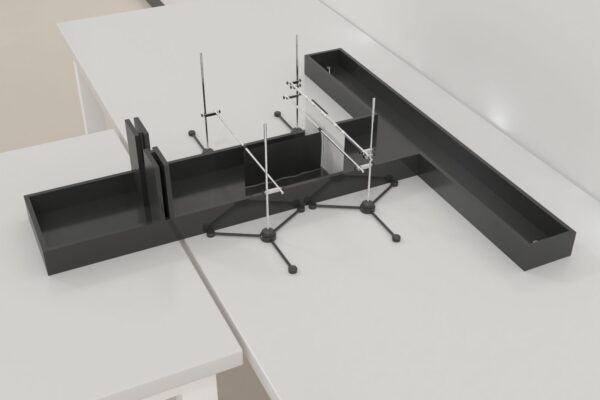The Split T-Maze was originally invented by Markowska and Savonenko (2002) as an adaptation of the standard rodent T-Maze used to assess spatial learning and memory in rodents. It comprises a T-Maze platform, which has a long stem and two choice arms, similar to the standard T-Maze. In addition, it includes removable components, comprising a hardware cloth partition, a plexiglass barrier, and a curtain that drapes over the two split stems. Moreover, a guillotine door is present after the starting platform, which prevents entry into the main stem during acclimation or between trials.
Mouse
$ 1990
Per Month- Acrylic T-shaped platform
- Stem: 54 × 13 cm
- Arms: 25 × 7 cm
- Starting platform: 16 cm long
- Guillotine door: 11 cm high and 6 cm wide
- Guillotine frame: 14 cm high and 11 cm wide.
- Cloth partition (6 cm high and 13 cm long)
- White opaque cloth curtain: 9cm high
- Clear plexiglass barrier (9 cm high and 5 cm wide)
- Food cup: 0.6 cm wide and 1 cm deep
Rat
$ 2390
Per Month- Acrylic T-shaped platform
- Stem: 87 × 20 cm stem
- Arms: 40 × 10 cm
- Starting platform: 25 cm long
- Guillotine door: 11 cm high and 6 cm wide
- Guillotine frame: 22 cm high and 18 cm wide.
- Cloth partition (10 cm high and 20 cm long)
- White opaque cloth curtain: 14 cm high
- Clear plexiglass barrier (14 cm high and 8 cm wide)
- Food cup: 1 cm wide and 1.5 cm deep
Introduction
The Rat Split T-Maze can be used to study the effect of brain lesions, toxins, and drugs on cognitive function since the task is sensitive to these parameters.
The Rat Split T-Maze without the partition, barrier, and curtain can be utilized as a standard T-Maze for the assessment of spatial memory and spontaneous alternation. For the assessment of spatial memory, a food reward is placed in one choice arm and the number of correct choices the subject makes in the baited versus the un-baited arm is analyzed. On the other hand, spontaneous alternation does not utilize food rewards but investigates if the subjects alternate their arm choices across trials to measure exploratory behavior and cognitive function.
Working memory and reference memory are assessed by the partition, barrier, and curtain. In this maze variation, a hardware cloth partition splits the stem into two halves. The plexiglass barrier present at the end of one-half of the partition prevents access from that side of the stem. The white cloth curtain, suspended in a frame perpendicular to the stem and extending across both sides of the stem, prevents the subject from seeing the plexiglass barrier. Therefore, reference memory is assessed by analyzing the number of entries into the blocked side of the stem. In addition, working memory is assessed by examining the number of entries the subject makes into the baited arm.
Documentation
The original Split T-Maze for rats comprises an acrylic T-shaped platform. It has an 87 × 20 cm stem and 40 × 10 cm arms. A starting platform measuring 25 cm long is separated from the stem by a guillotine door measuring 11 cm high and 6 cm wide, which is mounted in a frame that is 22 cm high and 18 cm wide.
A hardware cloth partition (10 cm high and 20 cm long) starts 20 cm from the guillotine door. It divides the stem into two halves lengthwise. A white opaque cloth curtain (14 cm high) is suspended in a frame perpendicular to the stem and extends across both sides of the stem near the end of the partition proximal to the arms. To prevent access to the arms from that side of the stem, a clear plexiglass barrier (14 cm high and 8 cm wide) suspended in a frame perpendicular to the stem is positioned behind one of the curtains.
A food cup measuring 1 cm wide and 1.5 cm deep is present 1 cm from the distal end of each arm. To avoid using olfactory signals, food rewards are placed beneath the ends of the arms and beneath both food containers. The maze has 5 cm walls to discourage the subject from jumping to the floor.
The maze should be surrounded by a broad diversity of local and distant cues. These can be taken out according to experimental needs. The Rat Split T-Maze can be converted to a standard T-Maze by removing the hardware cloth partition, plexiglass barrier, and curtain.
Training
Too much light can be aversive to the subjects; so proper lighting is necessary for the experimental room. The maze should be cleaned with ethanol after every trial.
The following is a sample protocol to assess spatial memory in rodents
Rat Split T-Maze Training
Give the subject one food reward in its home cage per day for a few days before training to acclimate the subject to the reward in a familiar environment. Set up the T-Maze without the plexiglass barrier, hardware cloth partition, or curtain. Place food rewards around the entire maze to encourage exploration. Place a pair of subjects in the maze and allow them to explore it. Conduct training once a day for three days. Place food only on the maze arms on the second day and then only at the ends of the arms on the third day. Conduct testing once the subject is comfortable exploring the maze by itself.
Forced Trial
Place a food reward at the end of one open arm and place a small barrier at the entrance of the other arm. Place the subject behind the guillotine door. Raise the door and allow the subject to enter the maze stem. Gently close the guillotine door. Allow the subject to enter the open arm and eat the food reward. Place the rat back at its starting position behind the closed guillotine door. Do not let the rat explore the maze. The rat must be aware that it has only eaten the reward from one location.
Choice Trial
Remove the barrier from the blocked choice arm and place the food in the arm that was previously unrewarded. Confine the rat in the starting position for a set amount of time in which longer waiting periods will increase task difficulty. Raise the guillotine door and allow the subject to enter the maze and choose a maze arm. Close the guillotine door. Repeat testing according to experimental needs.
The following is a sample protocol to test working memory versus reference memory in rodents:
This protocol allows the disassociation between working and reference memory. It is performed in the same manner as the previous protocol; however, the external cues are altered by relocating the maze to a different location, and a partition, barrier, and curtain in the T-Maze stem are utilized during the testing phase. In this protocol, the rat must relate a certain set of environmental stimuli with the memory of which side of the stem is blocked.
Training
Conduct training in the same manner as the previous protocol; however, move the maze to a different location to vary the demand upon reference memory
Testing
Place the hardware cloth partition, plexiglass barrier, and curtain on the maze. Start the forced trial. Allow the rat to make a correction and enter the open side of the stem if it enters the side of the stem that is blocked by the plexiglass barrier. Complete the forced trial, then conduct numerous choice trials.
Data Analysis
The following parameters can be observed using the Rat Split T-Maze:
Spatial memory assessment protocol:
- Number of times the subject entered the correct maze arm (baited arm)
- Number of times the subject entered the incorrect maze arm (unbaited arm)
Working memory versus reference memory assessment protocol:
- Number of correct entries into the baited arms
- Number of entries into the blocked side of the stem (reference memory errors)
- Number of re-entries into unbaited arms (working memory errors)
Literature review
Investigation of the effects of estrogen withdrawal and replacement on the working and reference memory of rats
Markowska and Savonenko (2002) utilized the Rat Split T-Maze to investigate the effects of estrogen withdrawal and replacement in middle-aged female Fisher-344 rats. The rats were divided into two groups: the ovariectomy group received ovariectomy surgery and the sham group received sham surgery with skin and muscles cut by ovaries spared. The Rat Split T-Maze utilized the delayed-nonmatching to-position (DNMP) task for behavioral testing.
Testing began a month after ovariectomy surgery and continued for 9 months totaling seven testing periods. The ovariectomy groups were divided into two subgroups (OVX1 group and OVX2 group) on the sixth month of testing (period 5). The OVX1 group and sham group received subcutaneous injections with 0.1 ml sesame oil, whereas, the OVX2 groups were injected subcutaneously with estrogen. Additionally, the OVX2 groups received estrogen implants five days before period 5 while the OVX1 group received the plants five days before period 7. The sham group received placebo implants.
During testing, the subject was placed in the starting position and was required to explore the maze. The correct side of the stem was randomly assigned to the rats and remained constant for each rat throughout testing. A black cloth curtain was placed on both sides of the stem and the plexiglass barrier behind one curtain prevented access to the arm on that side of the stem. Chocolate milk was placed in the food cup on the correct arm. In addition, cups filled with milk were placed below the arms and maze stem to prevent the olfactory cues from the correct arm from affecting results. Each daily session consisted of 11 trials in which rats performed one forced trial and ten free-choice trials.
The results indicated that ovariectomy had no impact on the DNMP task’s acquisition rate. During the first six days of training, there was no difference in the percentage of correct arm alternations across the groups. Both Sham and OVX rats learned how to make the correct choices in the stem of the T-maze (reference memory) in a similar manner. As a measure of reference memory, the accuracy of correct choices in the stem of the T-maze remained extremely high during the course of aging and was consistent in Sham, OVX, and estrogen-treated rats. Between testing sessions, there were no differences in group retention of the right stem choices. Aging resulted in fewer correct arm selections, which is a measure of working memory.
Summary
The Rat Split T-Maze is an adaptation of the standard rodent T-Maze used to assess spatial learning and memory, working versus reference memory, and spontaneous alternation in rodents.
- It comprises a T-Maze platform, which has a long stem and two choice arms. It also includes a guillotine door near the starting platform. Moreover, it includes a hardware cloth partition that splits the stem into two halves, a plexiglass barrier that blocks the end of one half of the stem, and a curtain that drapes over the two stem halves and prevents visual access to the barrier.
- Spatial memory is assessed by observing the number of correct choices the subject makes in the baited versus the un-baited arm.
- Reference memory is assessed by analyzing the number of entries into the blocked side of the stem. In addition, working memory is assessed by examining the number of entries the subject makes into the baited arm.
- Choice accuracy is affected by the duration of the inter-trial intervals in which shorter intervals display greater choice accuracy. On the other hand, longer delays increase task difficulty.
- Olfactory cues surrounding the maze may be required to prevent the subject from utilizing olfactory cues from the food reward for task performance.
References
Wenk G. L. (2001). Assessment of spatial memory using the T maze. Current protocols in neuroscience, Chapter 8, https://doi.org/10.1002/0471142301.ns0805bs04
Markowska, A. L., & Savonenko, A. V. (2002). Effectiveness of estrogen replacement in restoration of cognitive function after long-term estrogen withdrawal in aging rats. The Journal of neuroscience : the official journal of the Society for Neuroscience, 22(24), 10985–10995. https://doi.org/10.1523/JNEUROSCI.22-24-10985.2002



